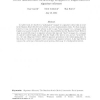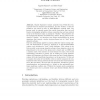324 search results - page 6 / 65 » A new signature scheme without random oracles |
TCC
2004
Springer
14 years 21 days ago
2004
Springer
In earlier work, we described a “pathological” example of a signature scheme that is secure in the Random Oracle Model, but for which no secure implementation exists. For that...
ACNS
2008
Springer
14 years 1 months ago
2008
Springer
We describe two new paradigms on how to obtain ordinary signatures that are secure against existential forgery under adaptively chosen message attacks (fully-secure, in short), fro...
CISC
2008
Springer
13 years 9 months ago
2008
Springer
One of the important applications of digital signature is anonymous credential or pseudonym system. In these scenarios, it is essential that the identity of the signer is kept secr...
ICISC
2004
13 years 8 months ago
2004
An identity (ID)-based signature scheme allows any pair of users to verify each other's signatures without exchanging public key certificates. With the advent of Bilinear maps...
EUROCRYPT
2003
Springer
14 years 17 days ago
2003
Springer
Abstract. Digital Signatures emerge naturally from Public-Key Encryption based on trapdoor permutations, and the “duality” of the two primitives was noted as early as Diffie-He...


